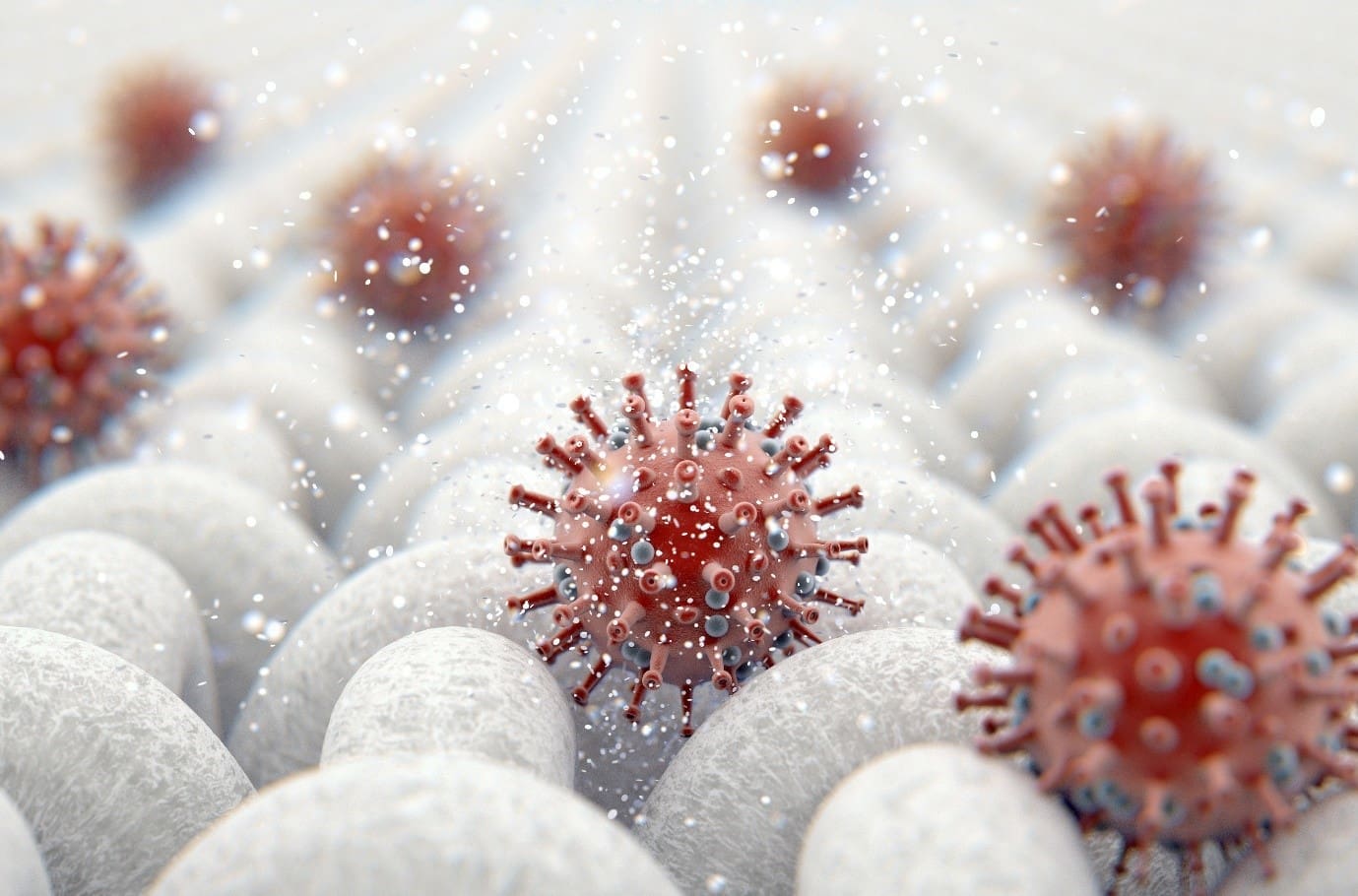As the nation wrestles with the Covid-19 pandemic, anti-viral textiles appears to have become the trendy expression in the business. Players state ant-viral textiles and fabrics battle the spread and transmission of infections through different materials embedded or coated on the fabric proving their findings with various tests performed.
Manufacturers such as Vardhman Textiles, Welspun India Ltd, Donear Industries, RSWM Ltd (Mayur), Arvind Ltd, and D’ Decor, and many more have marketed and launched anti-viral textiles for clothing and home furnishing uses, in partnership with international high tech (in Textiles)players, like HeiQ.
HeiQ Viroblock NPJ03 is one of the absolute first textile advancements on the planet to be demonstrated 99.99% viable against SARS-CoV-2 in the research facility. SARS-CoV-2 is a virus from the coronavirus family that causes COVID-19. Tests have been led by HeiQ with the Peter Doherty Institute for Infection and Immunity in Melbourne, Australia (Doherty Institute). HeiQ Viroblock is designed to inhibit the growth and persistence of bacteria and enveloped viruses on textile surfaces. The technology used is a combination of HeiQ’s registered silver technology and Vesicle technology. The silver infused technology pulls in the oppositely charged infectious viruses and makes a permanent bond with the viruses’ sulphur chain groups. Hence, the fatty spherical vesicle technology (Liposomes) assists with exhausting the viral layer of its cholesterol content in minutes, hence enabling the silver to pulverize the infection quickly.
Similar to all finishes, the antiviral finish also varies in effectiveness according to the concentration that is applied. The inclination is as following: 10% for Maximum performance, used for basic applications like face covers and dispensable clinical nonwovens; 8.5% for strong performance, 7% good performance, for less critical applications, for example, everyday pieces of clothing and home textiles.
HeiQ tested this technology for Residual virus by an adjusted ISO 20743 technique (Sendai virus), fast antiviral impact was exhibited within 2-5 minutes to exposure. The Antiviral technology was also tested following ISO 18184 as solid antiviral and ISO 20743 as solid antibacterial against encompassed viruses and bacteria. The technology is certified as safe and sustainable as all of its constituents are cosmetic grade, bio-based (72% bio-based carbon) and reused. The fabric lasts for 30 delicate home-washes at 60°C (140°F) and lasts up to 5 dry cleans on a wool fabric treated with Viroblock technology. The patent is pending for antiviral and antibacterial innovation.
HeiQ has listed its end-use as Medical textiles for protection, for example, utilized for face masks, air filters, clinical outfits, blinds, drapes; apparel, upholstery, sleeping cushions, mattresses, etc. The technology can be used for all fibre types, especially non-wovens.
Arvind Ltd., a textile to-retail conglomerate, has gone into a specialized joint effort with Swiss textile pioneer HeiQ Materials AG and Taiwanese Jintex Corporation to present antiviral Viroblock textile innovation for the very first time in India under its sub-brand Intellifabrix. A shirt made with this innovation would cost about ₹2,500 per metre, while the open fabrics will be estimated somewhere in the range of ₹600 and ₹1,000 per meter.
Donear Industries, which has collaborated with Swiss organization HeiQ to introduce the Neo-Tech anti viral textiles, which includes suiting and worsted textures. It is selling these items in the B2C segment, just as providing them to B2B clients.
Other worldwide textile organizations, for example, HealthGuard Corporation, have additionally collaborated with Indian players for anti-viral fabrics with claims dependent on international test standards.
Despite development in organizations selling fabric resistant to bacteria, viruses and fungi, there are no guidelines yet for such things from the ministries of Health or Textiles. There is no standard item for the use of anti-viral or anti-microbial fabrics. Different producers have their variants dependent on their advertising activities or client prerequisites.
Authorities said that while anti-microbial textiles could slow the development of microorganisms somewhat, they would not offer any guarantee against the Covid-19 infection, as such material won’t have the option to stop its infiltration through the fabric to the body, particularly at the seams. On the off chance that the textile can’t stop penetration of the infection, at that point, it isn’t extremely useful against Covid-19. The World Health Organization likewise doesn’t recognize any such textile fabric or technology.
Industry players said that innovation for hostile to viral or against microbial materials existed even before the Covid-19 pandemic and was being utilized to a great extent by doctors and health care workers. But the medical industry uses coveralls. A body coverall requires a textile with strong anti-viral properties, its seams are fixed and sealed so the likelihood of microbe entrance from needle punch zone lessens and there is no free opening at any point in the coverall through and through. Be that as it may, that is not the situation with common clothing apparel products. A typical piece of clothing clearly won’t be made like a coverall. It will have openings and air permeability(large pore size to allow breathability and comfort). COVID-19 virus is 120 nanometres, so it is critical to quantify pore size of the material which is labelled as anti-viral. The pore size ought to be under 120 nanometres, so the virus does not infiltrate the textile layer or seams. When it comes to maximum efficiency of anti-viral properties in apparel, fabric finish should be upheld strongly with sewing threads which are also treated with the anti-viral technology.
COVID-19 has placed the shoppers in a dim circumstance of what to pick, customers would prefer not to face any challenge in regards to their wellbeing and security. The consumer will rush to buy the newly launched Anti-viral clothing without realizing that none of it has been demonstrated 100% successful against the COVID-19. For all brands and retailers of apparel who want to innovate anti-viral fabrics tried and tested against SARS-CoV-2 need to comprehend the significance and vulnerability of this procedure and the impediments of what they are going to guarantee.
Written By-Prachi Gehlot (Intern)
References-
- ps://heiq.com/technologies/heiq-viroblock/
- https://www.thehindubusinessline.com/economy/policy/rise-in-anti-viral-fabric-launches-in-india-but-health-textile-ministries-have-no-guidelines-for-such-products/article32038446.ece
- https://in.apparelresources.com/technology-news/manufacturing-tech/anti-viral-fabrics-in-garments-marketing-gimmick-or-reality/

